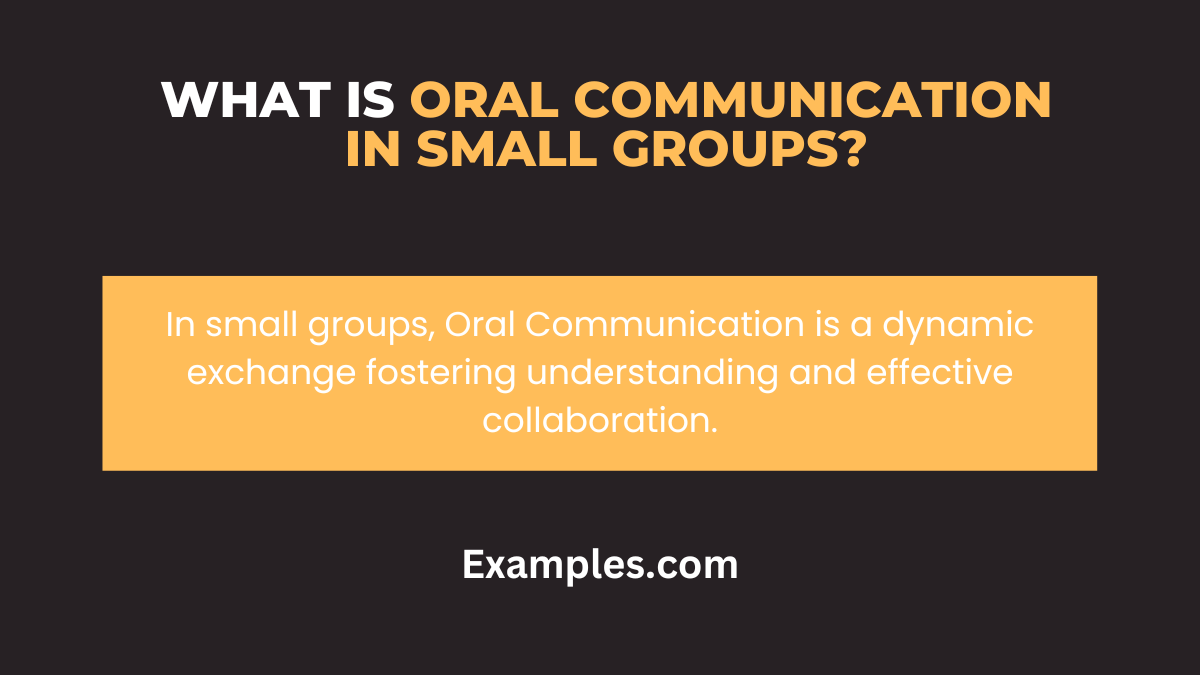Oral Communication in Small Groups
Explore the realm of Oral Communication in small groups, where effective dialogue is the key to successful collaboration and understanding. Enhance your group communication skills with expert insights and actionable tips.
What is Oral Communication in Small Groups?

Oral Communication in small groups involves the exchange of ideas, information, and feedback within a limited number of participants. It’s a dynamic process where active listening, clear expression, and understanding play pivotal roles, fostering cohesive group dynamics.
20 Oral Communication in Small Groups Examples
Enhance collaborative dynamics with Oral Communication in Small Groups. This dynamic process involves exchanging ideas, fostering understanding, and promoting effective group interactions. Discover actionable tips to navigate group discussions seamlessly and amplify the impact of your communication skills.
- Active Listening: Boost group cohesion by employing active listening techniques, such as summarizing others’ points before expressing your own.
Example:“To build on Sarah’s idea, I’d like to emphasize the importance of collaboration in our project.” - Concise Expression: Ensure clarity in small group discussions by being concise and focused in your communication.
Example:“In summary, our main goal is to streamline the process for better efficiency.” - Body Language Awareness: Leverage non-verbal cues for effective oral communication. Maintain eye contact and open body language to convey engagement and openness.
Example:“I appreciate the proposal, and I’m open to exploring alternative solutions.” - Feedback Loop: Establish a constructive feedback loop within the group, encouraging open dialogue to refine ideas collectively.
Example:“Your input is valuable; let’s discuss how we can incorporate your suggestions into the plan.” - Thinking Before Speaking: Encourage thoughtful responses by emphasizing the importance of thinking before speaking.
Example:“Before we decide, let’s each take a moment to consider the implications of each option.” - Speaking Clearly: Ensure effective communication by articulating thoughts clearly and avoiding jargon.
Example:“To clarify, our objective is to enhance customer satisfaction through personalized services.” - Tone Management: Navigate sensitive topics with a considerate tone, fostering a positive atmosphere for discussions.
Example:“I understand there are concerns; let’s address them collaboratively for a win-win solution.” - Avoiding Clichés: Enhance communication authenticity by steering clear of clichés and fostering original expression.
Example:“Rather than relying on clichés, let’s find unique ways to convey our commitment to excellence.” - Clarity in Communication: Prioritize clarity in group communication, ensuring everyone comprehends key messages.
Example:“Let’s break down the plan step by step to ensure everyone is on the same page.” - Confidence Boost: Instill confidence in group members by acknowledging their contributions and fostering a supportive environment.
Example:“John, your expertise in marketing will be invaluable; please share your insights.” - Eliminating Conversation Fillers: Enhance the effectiveness of group discussions by eliminating conversation fillers like “um” and “uh” for a more polished delivery.
Example:“Let’s strive for clear and concise communication without unnecessary fillers to maintain engagement.” - Making Eye Contact: Build trust and connection within the group by making consistent eye contact during discussions.
Example:“As we discuss, let’s make an effort to maintain eye contact to foster a sense of connection and understanding.” - Approaching Public Speaking: Approach small group discussions with the confidence of a public speaker, ensuring your message resonates with impact.
Example:“Even in our smaller setting, let’s infuse our communication with the confidence and clarity of public speaking.” - Effective Questioning: Elevate group engagement by incorporating effective questioning techniques, encouraging thoughtful responses.
Example:“What are your insights on this matter? Let’s open the floor for diverse perspectives.” - Storytelling Impact: Enhance the narrative of discussions through storytelling, making complex ideas more relatable and memorable.
Example:“Let me share a relevant experience that illustrates the potential challenges and opportunities we might face.” - Tailoring Messages: Tailor your messages to different audience segments within the group, ensuring relevance and resonance.
Example:“Considering our diverse roles, let’s customize our messages to address the specific needs and concerns of each team member.” - Understanding Non-Verbal Cues: Augment comprehension by paying attention to non-verbal cues, deciphering unspoken thoughts within the group.
Example:“I noticed some expressions during the discussion; let’s pause to ensure everyone is comfortable with our direction.” - Interpersonal Communication: Integrate principles of interpersonal communication for harmonious group dynamics, fostering empathy and collaboration.
Example:“Let’s approach our discussions with empathy, understanding each other’s perspectives for a collaborative outcome.” - Intrapersonal Communication: Acknowledge the role of intrapersonal communication within the group, recognizing the impact of self-awareness on effective interaction.
Example:“Before our meeting, take a moment for intrapersonal reflection to bring clarity to your contributions.” - Promoting Open-Mindedness: Cultivate an open-minded atmosphere within the group, encouraging diverse opinions and innovative ideas.
Example:“Let’s embrace an open mind during discussions, valuing different viewpoints for comprehensive decision-making.”
Advantages and Disadvantages of Oral Communication in Small Groups

| Advantages | Disadvantages |
|---|---|
| Real-Time Interaction: Enables immediate responses and dynamic dialogue. | Potential for Dominance: Certain members may dominate discussions, hindering diverse participation. |
| Enhanced Understanding: Non-verbal cues enhance comprehension within the group. | Limited Time: Time constraints may restrict the depth of discussions or decision-making. |
| Collective Problem-Solving: Harnesses the collective intelligence of the group for effective solutions. | Conflict Potential: Differing opinions may lead to conflicts within the small group. |
| Building Group Cohesion: Fosters a sense of unity and shared goals among members. | Communication Barriers: Language barriers or communication styles may impede effective interaction. |
| Flexibility: Allows for spontaneous adjustments and adaptability during discussions. | Lack of Individual Focus: Individual perspectives may be overshadowed in favor of group consensus. |
Characteristics of Oral Communication in Small Groups
Oral communication in small groups exhibits distinct characteristics that contribute to effective interaction and collaboration. Understanding these features is pivotal for optimizing group dynamics.
- Interactivity: Small group communication encourages active participation, facilitating real-time interaction and engagement among members.
- Informality: The setting promotes a more relaxed and informal atmosphere, fostering open dialogue and free expression of ideas.
- Collaboration: Participants work collectively, leveraging diverse perspectives to achieve common goals and solutions.
- Immediate Feedback: Feedback is immediate, enabling quick adjustments and clarification of ideas within the group.
- Group Cohesion: Effective oral communication strengthens the bonds among group members, promoting a sense of unity and shared purpose.
- Flexibility: Small groups allow for adaptability, enabling spontaneous discussions and adjustments based on the group’s evolving needs.
- Shared Responsibility: Communication tasks are distributed, promoting a sense of shared responsibility and accountability within the group.
- Non-Verbal Cues: Participants rely on non-verbal cues, such as body language and facial expressions, enhancing understanding in the absence of elaborate verbal communication.
Types of Oral Communication in Small Groups
| Type | Description |
|---|---|
| Informal Discussions | Spontaneous conversations that allow members to freely share ideas and opinions. |
| Formal Presentations | Structured presentations where one or more members convey information or proposals to the group. |
| Brainstorming Sessions | Creative sessions where members generate ideas collectively, fostering innovation and problem-solving. |
| Decision-Making Conversations | Discussions focused on reaching a consensus or making decisions collaboratively within the group. |
| Problem-Solving Dialogues | Strategic discussions aimed at identifying, analyzing, and resolving challenges or issues facing the group. |
| Planning and Coordination Talks | Communication geared towards organizing tasks, assigning roles, and coordinating efforts for collective goals. |
Oral communication in small groups is a multifaceted process that requires a harmonious blend of active listening, clear expression, and effective collaboration. These interactions, characterized by their interactivity, informality, and focus on collective problem-solving, play a crucial role in building strong, cohesive groups. Whether in informal discussions or structured decision-making conversations, the ability to communicate assertively and empathetically within a small group setting is vital for achieving common goals and fostering positive group dynamics.



